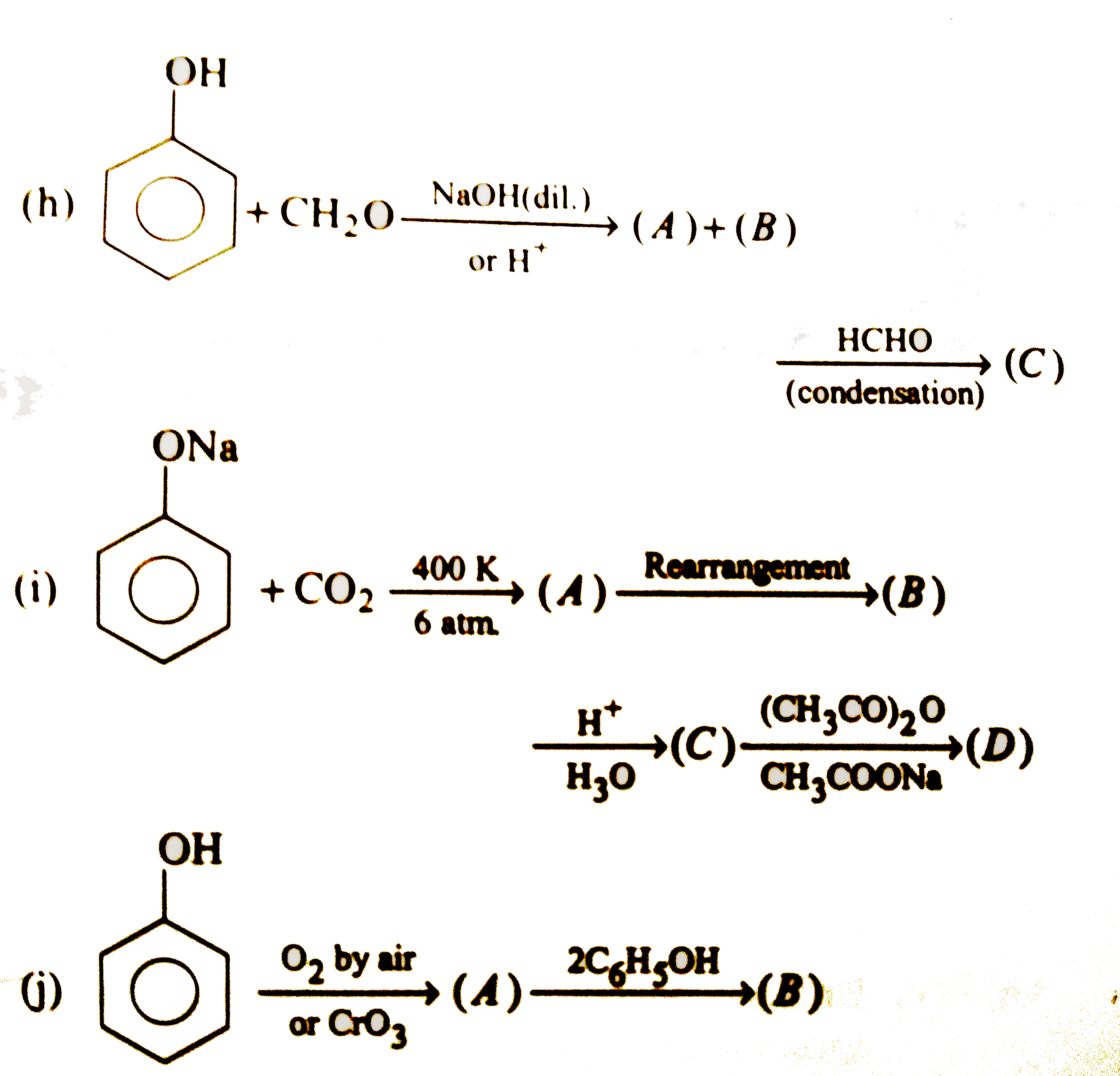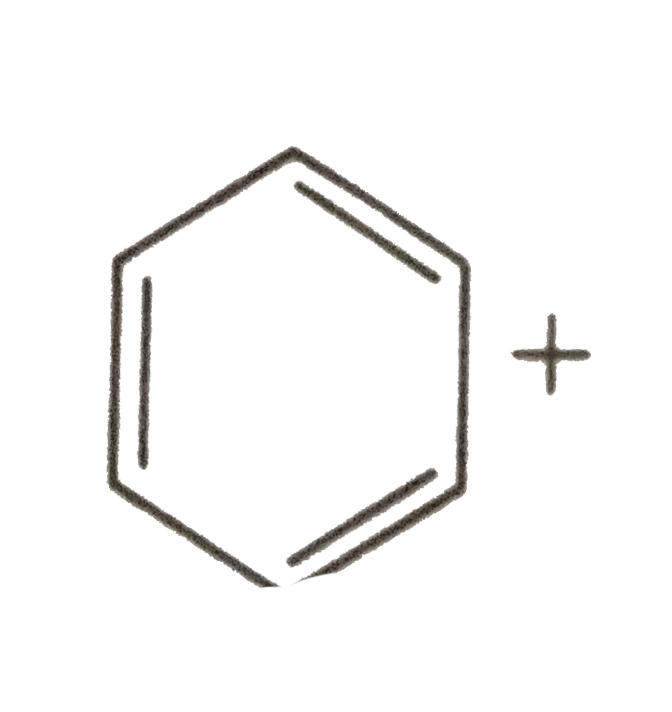Complete Solutions to PHENOLS of chapter ALCOHOLS, PHENOLS AND ETHERS of Class 12 book with complete answers and questions
| Class 12 | CHEMISTRY |
| Chapter | ALCOHOLS, PHENOLS AND ETHERS |
| OP TANDON | PHENOLS |
| Number Of Questions | 91 |
| Academic Year | 2023-24 |
Complete the following equations `:`
(i) `C_(6)H_(5)OH+Br_(2)overset(H_(2)O)(rarr)`
(ii) `C_(6)H_(5)OH +CHCl_(3)underset(343K)overset(NaOH(aq.))(rarr)`
(iii) `C_(6)H_(5)OH+HNO_(3)overset(H_(2)SO_(4)("conc."))(rarr)`
(iv) `C_(6)H_(5)ONa+CO_(2)underset(4-7atm)overset(398K)(rarr)`
(v) `C_(6)H_(5)OH+(C_(2)H_(5))_(2)SO_(4)underset(Delta)overset(NaOH(aq.))(rarr)`
(vi) `C_(6)H_(5)ONa+CH_(3)OHunderset(Delta)overset(ThO_(2))(rarr)`
(vii) `C_(6)H_(5)OH+(CH_(3)CO)_(2)Ounderset(orCH_(3)COONa)overset("Pyridine")(rarr)`
(viii) `C_(6)H_(5)OH+CH_(3)Cloverset(AlCl_(3)("anhyde."))(rarr)`

View SolutionIdentify the final product in each reaction.


View SolutionIdentify the unknown compounds


View SolutionArrange the following `:`
(a) `C_(6)H_(5)OH,m-ClC_(6)H_(4)OH` and `p-ClC_(6)H_(4)OH` in decreasing order of their acidity.
(b) `m-NO_(2)C_(6)H_(4)OH,C_(6)H_(5)OH` and `p-NO_(2)C_(6)H_(4)OH` in decreasing order of their acidity.
(c ) `o^(-),m-` and `p-` bromophenol in order of increasing basicity.
(d) `o^(-),m-` and `p-`nitrophenol in order of increasing basicity.
(e ) Carbonic acid , phenol , p-nitrophenol and benzoic acid in order of increasing acidity.
(f) m-Cresol,phenol,m-chlorophenol and m-nitrophenol in order of increasing acidity.
View SolutionAnswer the following `:`
(i) Phenol is more acidic than ethyl alcohol.
(ii) Phenol is an acid but does not react with `NaHCO_(3)`.
(iii) Although phenoxide ion has more number of resonating structures than benzoate ino, benzoic acid is stronger acid than phenol . Why ?
(iv) Name the phenol with molecular formula `C_(7)H_(8)O` which on treatment with `Br_(2)` water readily gives a precipitate of `C_(7)h_(5)OBr_(3)`.
(v) Unlike phenol, 2,4-dinitrophenol and 2,4,6-trinitrophenol are soluble in aqueous sodium carbonate solution.
(vi) Phenol has higher boiling than toluence. although they have almost the same molecular mass.
(vii)Ortho nitro phenol is steam volatile while para nitro phenol is not.
(viii) In Kolbe's reaction, instead of phenol, phenoxide ion is treated with `CO_(2)`.
(ix) Nucleophilic substitution reactions are not very common in phenols.
(x) The dipole moment of phenol is smaller than that of methanol.
View SolutionHow the following pairs can be distinguished ?
(i) Phenol and benzoic acid.
(ii) Phenol and glycerol.
(iii) Phenol and ethyl alcohol .
(iv) Phenol and salicyclic acid.
(v) 1-Phenylethanol and 2-phenylethanol.
(vi) Phenol and benzyl alcohol.
(vii) Phenol and acetic acid.
(viii) Phenol and cyclohexanol.
View SolutionWhat happens when ?
(i) Cumene hydroperocide is treated with dilute `(H_(2)SO_(4))`.
(ii) Phenol is distilled with `C C l_(4)` in presence of aqueous NaOH.
(iii) Phenol is distilled with phthalic anhydride in the presence of concentration `H_(2)SO_(4)`.
(iv) Benzenediazonium chloride is treated with alkaline ice-cold aqueous solution of phenol.
(v) Phenol reacts with acetic anhydride in presence of sodium acetate.
(vi) Phenol is heated with ammonia in presence of anhydrous `ZnCl_(2)` at 573K.
(vii) Phenol is refluxed with con. `H_(2)SO_(4)` at 373K.
(viii) Phenol condenses with excess of formaldehyde in presence of sodium hydroxide for a long period.
(ix) 2,4,6-Trinitrophenol is heated with zinc dust.
(x) Phenol reacts with benzoyl in presence of NaOH.
(xi ) Phenol is treated with neutral `FeCl_(3)`.
(xii) Phenol is treated with bromine water.
(xiii) Phenol is treated with conc. `HNO_(30` in presence of conc. `H_(2)SO_(4)`.
(xiv) Phenol is treated with methyl chloride in presence of anhydrous `AlCl_(3)`
(xv) Phenol is hydrogenated in presence of nickel catalyst at 473K-533K.
View SolutionHow will you convert phenol into ?
9i) Salicylaldehyde (Reimer-Tiemann reaction )
(ii) Salicylic aci (Reimer -Tiemann reaction )
(iii) p-Hydroxyazobenzene
(iv) Anisole
(v) Methyl salicylate
(vi) Phenyl salicylate ltbr. (vii) Phenyl ethanoate
(viii) Picric acid
(ix) Phenolphthalein
(x) Aspirin ( Acetylation of salicylic acid)
(xi) 4-Nitrophenol
(xii) Cyclohexanol (xiii) 2,4,6- Tribromophenol
(xiv) p-Benzoquinone
(xv) Aniline
(xvi) 4-Bromophenol.
View SolutionDescribe the following `:`
(i) Reimer -Tiemann reaction
(ii) Kolbe's reaction
(iii) Schotten-Baumann reaction
(iv) Coupling reaction of phenol
(v)Fries rearrangement
(vi) Friedel -Crafts alkylation reaction
View SolutionCarbolic acid is
View SolutionBenzyl alcohol and phenol can be distinguished by using
View SolutionWhich of the following reagents may be used to distinguish between phenol and beznoic acid ?
View SolutionWhen sodium benzene sulphonate is fused with sodium hydroxide (solide), the product formed is `:`
View SolutionWhen phenol is treated with excess of bromine water, it gives
View SolutionPicric acid is a yellow coloured compound. Its chemical name is
View SolutionSodium phenoxide when heated with `CO_(2)` under pressure at 398K gives `:`
View SolutionPhenol when condensed with phthalic anhydride in the presence of conc. `H_(2)SO_(4)`, yields `,`
View SolutionPhenol is heated with `C Cl_(4)` and alkaline `KOH` when salicylic acid is produced. The reaction is known as
View SolutionPhenol reacts with bromine in carbon disulphide at low temperature to give
View SolutionOf the two compounds shown below , the vapour pressure of B at a particular temperature is

View SolutionReaction of phenol with chloroform in presence of dilute sodium hydroxide finally introduces which one of the following functional group ?
View SolutionPhenols react with ferric chloride solution to give `:`
View SolutionWhich one is the most acidic compound?
View SolutionThe formation of salicyclic acid from phenol using NaOH and `CO_(2)` is known as `:`
View SolutionWhich one of the following compounds has the most acidic nature?
View SolutionCumene `underset((II)H_(2)O,H^(+))overset((i)O_(2))(rarr) (X)` and (Y) ,
(X) and (Y)respectively are `:`
View Solution `+C_(2)H(5)I underset("Anhyde."C_(2)H_(5)OH)overset(.^(-)OC_(2)H_(5))(rarr)?`
`+C_(2)H(5)I underset("Anhyde."C_(2)H_(5)OH)overset(.^(-)OC_(2)H_(5))(rarr)?`
View SolutionPhenol `underset("distillation")overset("Zinc")(rarr)(A)underset("conc."HNO_(3) "at 333K")overset("conc." HNO_(3))(rarr)(B)underset("NaOH")overset(Zn)(rarr)(C )`
In the above reaction, compounds (A), (B) and (C ) are `:`
View Solutionthe most volatile compound is
View Solution
The product formed in the reaction is `:`
View SolutionPhenol on standing in air develops a red colour due to formation of `:`
View SolutionPhenol on heating with alcoholic with KOH and chloroform undergoes `:`
View SolutionNeutral `FeCl_(3)` gives purple colour with `:`
View SolutionKolbe Schmitt Reaction
View SolutionWhich of the following does not give effervescence with `NaHCO_(3)` ?
View SolutionPhenol on treatment with conc. `HNO_(3)` gives
View SolutionReaction of phenol with dil. `HNO_(3)` gives
View SolutionWhen phenol reacts with benzene diazonium chloride , the product obtained is `:`
View SolutionWhen phenol reacts with chloroform and an alkali, the compound formed is salicylaldehyde. If pyrene is used in place of chloroform, the product obtained is `:`
View SolutionOrtho -nitrophenol is less soluble in water than `p`-and `m-`nitrophenols because
View SolutionIntramolecular hydrogen bonding is found in `:`
View SolutionIntramolecular rearrangement of phenyl acetate to give o- and p-hydroxy acetophenone in presence of anhydrous `AlCl_(3)` is known as `,`
View SolutionPhthalic anhydride on heating with resorcinol in the presence of conc. `H_(2)SO_(4)` gives `:`
View SolutionDyes are formed when benzene diazonium salts are coupled with `:`
View SolutionIdentify 'C' in the following `:`
 `CH_(3)-underset(Cl)underset(|)(C)H-CH_(3)underset(HCl)overset("Anhyde."AlCl_(3))(rarr)(A) underset(403K) overset(O_(2))(rarr) (B) underset(373K)overset(H_(2)SO_(4))(rarr)"Phenol"+(C )`
`CH_(3)-underset(Cl)underset(|)(C)H-CH_(3)underset(HCl)overset("Anhyde."AlCl_(3))(rarr)(A) underset(403K) overset(O_(2))(rarr) (B) underset(373K)overset(H_(2)SO_(4))(rarr)"Phenol"+(C )`
View SolutionWhich of the following orders is true regarding the acidic nature of phenols ?
View SolutionCatechol on heating with phthalic anhydridee in the presence of conc. `H_(2)SO_(4)` gives `:`
View SolutionThe increasing order of acid strength amon p-methyoxy phenol (I), p-methyl phenol (II) and p-nitrophenol (III) is is `:`
View Solution`1,2,3-`trihydroxybenzene is also known as
View SolutionThe correct order of acid strength of the following substituted phenol in water at `28^(@)C` is `:`
View SolutionIn the following reaction, the product 'X' is `:`

View SolutionIn the following compounds

The order of acidity is-
View SolutionWhich of the following is sparingly soluble in water ?
View SolutionWhen `FeCl_(3)` is added to phenol `:`
View SolutionSalicylaldehyde can be prepared from phenol by
View SolutionWhich one of the following properties is exhibited by phenol ?
View SolutionStrength of acidity is in order:

View SolutionThe product of the following reaction is `:`

View SolutionThe reaction in which phenol differs from alcohol is `:`
View SolutionP- cresol react with chloroform in alkaline medium to give compound `(A)` which adds `HCN` to form `(B)`. The latter on acidic hydrolysis gives chiral carboxylic acid. The structure of carboxylic acid is :
View SolutionThe structure of the compound that gives a tribromo derivative on treatment with bromine water is `:`
View Solution
The electrophile involved in the above reaction is:
View SolutionIsopropyl benzene is oxidised in the presence of air to a compound 'A'. When compound 'A' is treated with dilute mineral acid, the armatic product formed is :
View SolutionPhenol can be distinguished from ethanol by the following reagents except
View SolutionThe reaction,
`C_(6)H_(5)ONa +CO_(2)+H_(2)O rarr C_(6)H_(5)OH+NaHCO_(3)`
suggests that `:`
View SolutionTwo aromatic compounds having formula `C_(7)H_(8) O` which are easily identified by `FeCl_(3)` solution test (violet colouration ) are `,`
View SolutionThe conversion of m-nitrophenol to resorcinol inivolves respectively`:`
View SolutionWhen benzene sulphonic acid and P-nitrophenol are treated with `NaHCO_3`, the gases released, respectively, are :
View Solution(I) 1,2-Dihydroxy benzene
(II) 1,3-Dihydroxy benzene
(III) 1,4-Dihydroxy benzene
(IV) Hydroxy benzene
The increasing order of boiling points of the above-mentioned alcohols is:
View Solution `+Cl-CH_(2)CH_(2)CH_(3)overset(AlCl_(3))(rarr) P underset((ii)H_(2)O)overset((i)O_(2)//Delta)(rarr)Q+` Phenol
`+Cl-CH_(2)CH_(2)CH_(3)overset(AlCl_(3))(rarr) P underset((ii)H_(2)O)overset((i)O_(2)//Delta)(rarr)Q+` Phenol
The major products P and Q are `:`
View SolutionThe reaction,

is an example of `,`
View SolutionWhat amount of bromine will be required to convert `2g` of phenol into `2,4,6-` tribromphenol
View Solution
The above transformation proceeds through
View SolutionPhenol is more acidic than alcohol because `:`
View SolutionPhenol when it first reacts with concentrated sulphuric acid and then with concentrated nitric acid gives:
View SolutionPhenol is heated with a solution of mixture of `KBr` and `KBrO_(3)`. The major product obtained in the above reaction is
View SolutionAmong the following, which is least acidic ?
View SolutionThe reaction of
 with HBr gives predominantly `:`
with HBr gives predominantly `:`
View SolutionCompound `A,C_(7)H_(8)O`, is insoluble in water, dilute `HCl`, and aquenous `NaHCO_(3)`, it dissolves in dilute `NaOH`. When `A` is treated with bromine water is is converted rapidly into a compound of formula `C_(7)H_(5)Obr_(3)`. The structure of `A` is
View SolutionBenzoylation of phenol in alkaline medium is known as `:`
View SolutionThe structure of the product (P ) of the following reaction is `:`

View SolutionThe major product obtained on interaction of phenol with sodium hydroxide and carbon dioxide is :
View SolutionIn the reaction for dinitration,

the major dinitrated product (X) is `:`
View SolutionIdentify the product in the following reaction `:`

View SolutionArrange the following compounds in the order of decreasing acidity.
I II
II  III
III  IV
IV 
View SolutionComplete the following reaction

View SolutionSodium phenoxide when heated with `CO_(2)` under pressure at `125^(@) C` yield a product which on acetylation gives product `C`

View SolutionWhich of the following compounds is most acidic ?
View SolutionThe reaction which involves dichloro carbene as an electrophile is :
View SolutionThe product of the reaction given below is :

View SolutionThe correct statement(s) about the following reaction sequence is (are)
Cumene `(C_(9)H_(12))underset((ii)H_(3)O^(+))overset((i)O_(2))rarrPoverset(CHCl_(3)//NaOH)rarr`
Q(major)+R(minor), `Q underset(PhCH_(2)Br)overset(NaOH)rarrS`
View Solution
PHENOLS questions and complete solutions for chapter ALCOHOLS, PHENOLS AND ETHERS of G.R. BATHLA & SONS CHEMISTRY (HINGLISH) of Class 12
All Exercises from OP TANDON Class 12 CHEMISTRY ALCOHOLS, PHENOLS AND ETHERS
- (C )ETHERS
- ASSERTION-REASON
- BRAI STORMING PROBLEMS
- ETHERS
- ETHERS Passage 6
- Ethers SET1:
- ILLUSTRATION OF OBJECTIVE QUESTINS
- LINKED COMPREHENSION Passage 1
- Matching Type
- MATRIX -MATCH
- OBJECTIVE QUESTIONS (LEVEL-A)
- OBJECTIVE QUESTIONS (LEVEL-B)
- passage 2
- Passage 3
- Passage 4
- Passage 5
- Passage 7
- PHENOLS
- PROBLEM
- PROBLEM FOR PRACTICE
- PROBLEMS BASED ON STRUCTURE AND PROPERTIES
- SET II
- SETII
- SINGLE INETER ANSWER TYPE QUESTIONS / ALCOHOLS AND PHENOLS
- Some SOLVED PROBLEMS